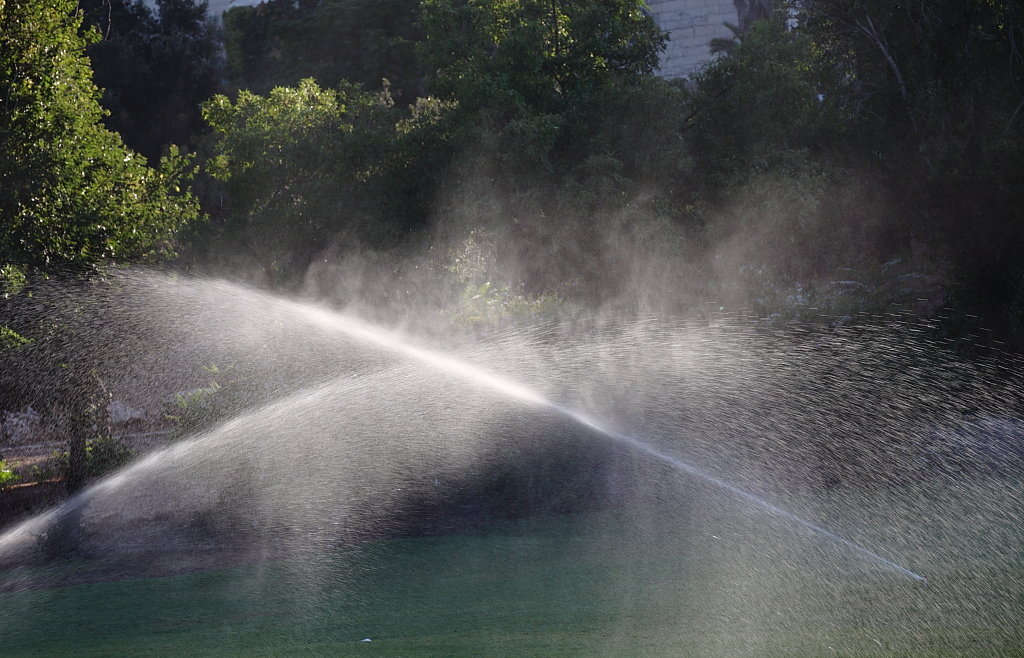
According to the University of Michigan Division of Plant Sciences department, 80% of the average homeowner’s water usage takes place outside of the home. Watering their lawn being the main source of that percentage. City or county bans on water happen whether we like it or not so it’s a good idea to understand how to optimize your water usage, especially during the growing season when water bans are most common.
To help you avoid brown wilted spots all over your lawn, we’ve gathered together a few tips and tricks to help conserve water and manage your lawn’s health.
How To Identify a Lawn That Needs Water

There are a few different ways to tell if your lawn needs water. The most obvious sign of course is when the grass blades start wilting, turning brown, and appearing dead. But there are some small signs to be on the look out for before it gets to that point.
For example, if you notice that footprints are left in the lawn for a while after someone’s been walking through then that’s a sign that your lawn needs water. Healthy grass blades bounce right back into their original upright shape and texture after being trampled. The blades could also turn a purple tint or start to fold and roll hot dog style.
If your lawn is going into its dormancy cycle the crown (the area at the base of the grass plant) should still have a shade of green to it. If it doesn’t and it’s completely brown this is bad. This means that you’re going to want to water immediately. During the dormancy period lawns should still be watered at least one inch per two weeks to prevent letting it die completely.
You can always check the texture of the soil for dampness. Just carefully excavate about six inches of dirt and inspect it. If it’s cracked and brittle and tiny chunks of dirt flake off easily then your lawn needs to be watered. If it’s at all damp or at least sticking together with a sort of playdough texture then congrats – you’ve successfully applied enough water to your lawn.
Ways to Prepare for Drought

There’s a few precautions that you can take during the spring and fall to help with your lawn’s drought tolerance during the summer. The ultimate goal here is to get the root system to reach as far down into the soil as possible. The target measure being six inches deep
The bullet list of lawn care tips below will help your roots big time:
- Don’t irrigate heavily in the spring to give your grass a “boost” for the summer. Instead, let it establish itself naturally.
- Set your mower higher to avoid scalping your lawn.
- Grass should be mowed as tall and frequent as possible with a sharpened mower blade to establish a dense canopy and root system. Taller grass means longer roots which allows the plant to absorb more water from the ground.
- In the fall season it’s a good idea to feed your lawn with nitrogen if it’s a cool-season grass. Such as Kentucky bluegrass, tall fescue, and perennial ryegrass.
- Aerate your lawn in the fall or spring to alleviate soil compaction and allow for optimal water, air, and nutrients.
How Much Water Your Lawn Needs
Soil in Missouri typically takes an hour to absorb a ½ inch of water and most grass types only need about an inch or so of water per week. It’s better to water less frequently and more at once so if you have a sprinkler system that puts out an ½ of water in an hour then just water your lawn an hour at a time twice a week.
A good way to tell if you’re watering enough is to set a can of tuna out on the lawn. Tuna cans are about an inch tall so it’s a good makeshift rain gauge if you don’t already have one.
There’s a couple different ways to inspect your soil yourself to audit your watering habits. But we have a very simple way to get the job done.
Check a few sections in your lawn to inspect whether or not there’s enough moisture in the soil. Using a shovel, carefully cut a wedge of lawn about six inches deep and feel the soil. The wedge of soil, roots, and grass can be easily put back in place when you’re done – with no harm to the lawn. Once again if it’s cracked and dry then it’ll be harder for the roots to continue to reach down further into the soil.
You can estimate the moisture levels in the soil by taking golf ball sized chunks of dirt and squeezing them. If drops of water can be squeezed out then you’re likely watering too much. Soil shouldn’t be damp for longer than a few minutes after watering. But if it’s dry and cracked and flaky then you aren’t watering enough.
When to Water
The best time to water your lawn is in the early morning hours between 5 and 8 a.m. It’s early enough to not have to worry about the moisture being evaporated too soon and late enough to not have to worry about fungal turfgrass diseases caused by moisture sitting on the grass for too long. The key is to avoid watering in the middle of the day while the sun’s out and conditions are typically more windy.
That does it for our lawn watering tips to help out Kansas City residents and homeowners get the most out of their watering habits.
Have questions about lawn care in Kansas City? Feel free to share your thoughts with us in the comments section below.





